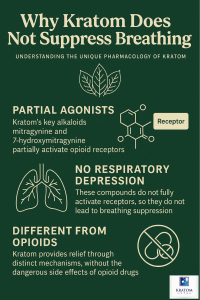🌿 Understanding How Kratom Differs from Opioids
Kratom (Mitragyna speciosa) has become widely recognized for its potential to provide natural relief, focus, and calm — but unlike opioids, it does not suppress breathing.
This single fact makes kratom fundamentally different from traditional narcotics, and it’s one reason why many people turn to kratom as a natural alternative.
Let’s look at the science behind this distinction and what makes kratom’s active alkaloids so unique.
🔑 Key Points
-
Kratom’s main alkaloids, mitragynine and 7-hydroxymitragynine, act as partial agonists, not full opioids.
-
They do not slow or suppress breathing, even at higher doses.
-
Opioids can cause respiratory depression by fully activating mu-opioid receptors in the brain.
-
Kratom’s partial receptor binding offers comfort and balance without the danger of respiratory shutdown.
-
Lab-tested kratom ensures natural alkaloid ratios and product purity.
🧬 The Science of Breathing and the Brain
 To understand why kratom doesn’t suppress breathing, it helps to know how respiratory depression occurs.
To understand why kratom doesn’t suppress breathing, it helps to know how respiratory depression occurs.
Your brainstem regulates breathing automatically. Opioids like morphine, fentanyl, and oxycodone fully activate mu-opioid receptors in this region. When that happens, the signal that tells your lungs to inhale and exhale becomes dangerously weak — this is what causes overdose-related deaths.
Mitragynine, kratom’s primary alkaloid, binds to some of these same receptors — but in a completely different way. It acts as a partial agonist, meaning it fits into the receptor but only triggers a mild response. The result is comfort and relief without shutting down the respiratory drive.
This unique pharmacological profile is what makes kratom fundamentally different from opioids, both in structure and in safety.
⚗️ How Kratom’s Alkaloids Work Differently
The two key alkaloids in kratom — mitragynine and 7-hydroxymitragynine — interact with the body in complex but gentle ways.
-
Mitragynine: The most abundant alkaloid (about 60–70% of kratom’s alkaloid content). It acts primarily on mu-opioid receptors, but it only partially activates them. It also affects adrenergic and serotonergic systems, helping balance energy and mood.
-
7-Hydroxymitragynine: Present in very small amounts (<0.02%), it’s more potent but short-acting. Even so, its concentration in natural kratom is too low to cause respiratory suppression.
Because these compounds do not fully activate opioid receptors, they cannot override the body’s natural breathing reflex. Studies show that even at high doses, mitragynine does not cause the same pattern of respiratory depression seen with drugs like heroin or oxycodone.
⚖️ Kratom vs. Opioids: The Key Differences
| Feature | Kratom (Mitragynine) | Opioids (Morphine, Fentanyl, etc.) |
|---|---|---|
| Receptor Type | Partial mu-opioid receptor agonist | Full mu-opioid receptor agonist |
| Effect on Breathing | No respiratory suppression | Can cause fatal respiratory depression |
| Source | Natural plant (coffee family) | Synthetic or poppy-derived |
| Overdose Risk | Extremely low | High |
| Common Use | Natural wellness support | Prescription or illicit pain relief |
In short, kratom’s action is modulating, not overpowering**.** It interacts with the body’s natural systems to support balance — rather than hijacking them.
🌿 Why “Partial Agonist” Matters
When a compound is a partial agonist, it produces limited activity at receptor sites. This means the body’s normal signals continue to function, including those that control breathing.
For example, buprenorphine — a medication used in opioid addiction recovery — is also a partial agonist. Like kratom, it provides relief without fully shutting down respiratory function.
This is a crucial distinction: kratom’s effects exist within a safety ceiling that prevents it from producing life-threatening breathing suppression.
🧪 Lab Testing: Ensuring Safe, Natural Ratios
Not all kratom is created equal. Alkaloid levels can vary depending on where and how the leaves are grown, dried, and processed.
That’s why third-party lab testing is essential.
At KratomUSA, every batch is:
-
Independently tested for mitragynine and 7-hydroxymitragynine content.
-
Verified for purity, ensuring no synthetic alteration or adulteration.
-
Screened for heavy metals and contaminants to guarantee safety.
Lab-tested kratom ensures you’re receiving natural alkaloid ratios exactly as nature intended — and peace of mind knowing your product is safe and transparent.
💬 What Real Users Say
“I started using kratom after prescription pain meds made me feel groggy. Kratom helped my pain but never affected my breathing or energy.” — Jamie P.
“It’s comforting to know kratom isn’t an opioid and that it’s tested for safety. It helps me relax naturally.” — Monica L.
“Kratom gave me relief without the scary side effects of prescription meds. It’s been a game changer.” — Ethan R.
❓ FAQ
Q: Why do some people confuse kratom with opioids?
A: Because it binds to some of the same receptors in the brain. But kratom’s alkaloids bind partially, not fully — meaning no respiratory suppression or overdose risk like opioids.
Q: Can kratom cause overdose?
A: Pure kratom has not been shown to cause fatal respiratory depression. Overdose reports are typically linked to adulterated or mixed products.
Q: Is kratom safe to use with other substances?
A: It’s safest to use kratom on its own. Mixing it with depressants like alcohol, opioids, or benzodiazepines increases risk.
Q: Does kratom affect everyone the same way?
A: No. Effects can vary by strain, dose, and body chemistry — but kratom’s natural alkaloids maintain a safety ceiling that helps prevent respiratory suppression.
🌿 Final Thoughts
Kratom’s ability to support comfort and calm without suppressing breathing is one of its most important distinctions from opioids. Its alkaloids — primarily mitragynine — interact gently and naturally with the body, creating balance rather than harm.
When used responsibly and purchased from lab-tested, verified sources like KratomUSA, kratom offers a safe, plant-based alternative that has stood the test of time.
Kratom isn’t an opioid — it’s a natural botanical with a complex chemistry designed to support wellness, not suppress life. 🌿


